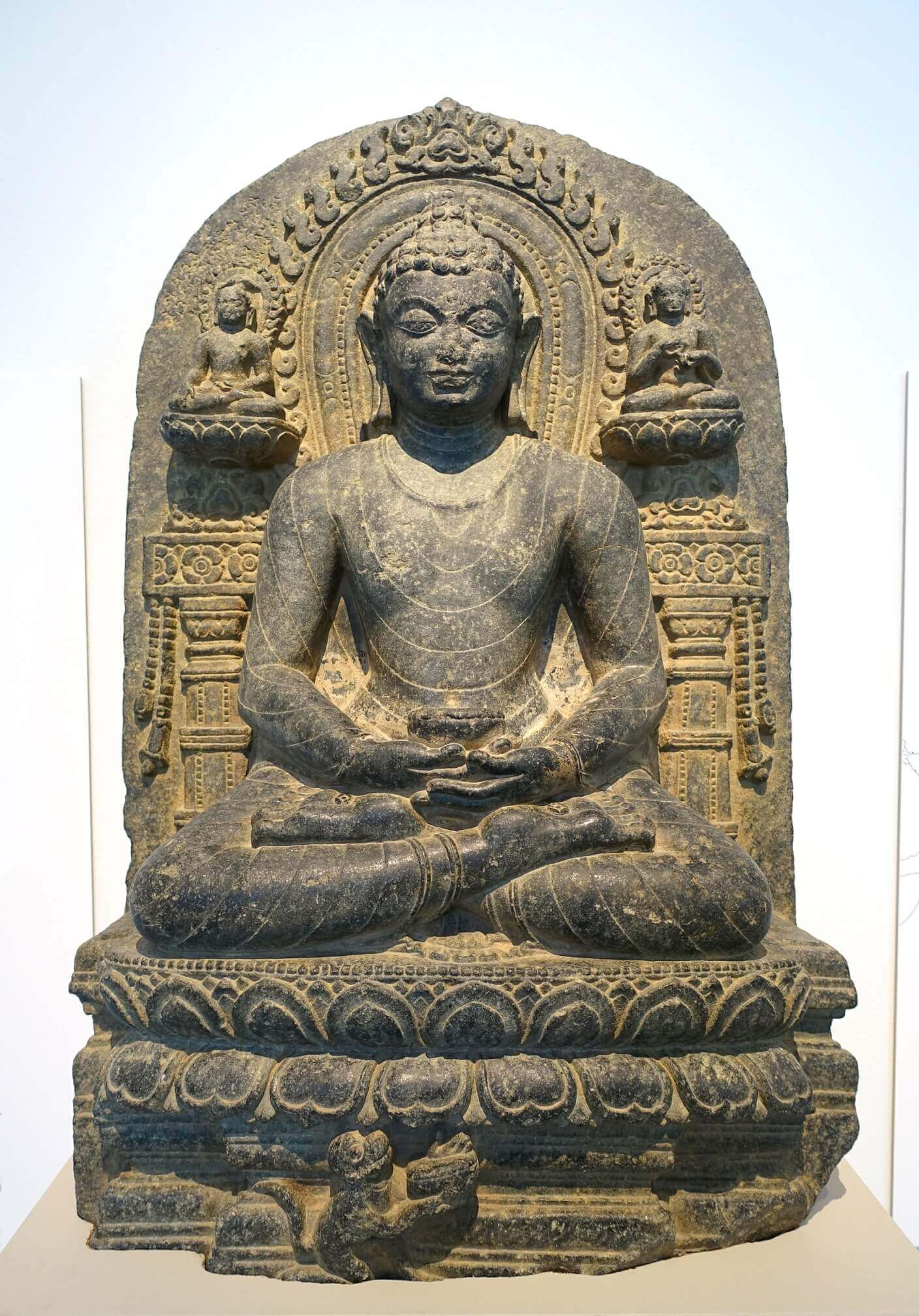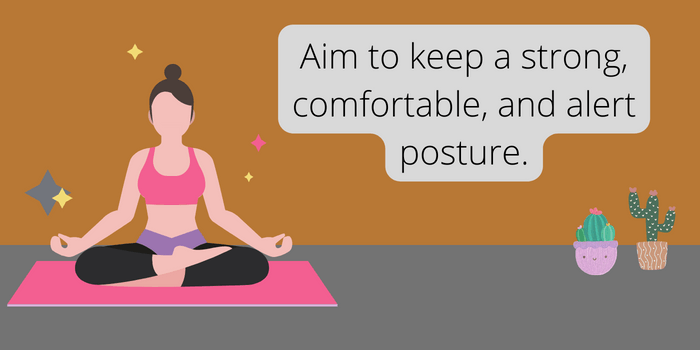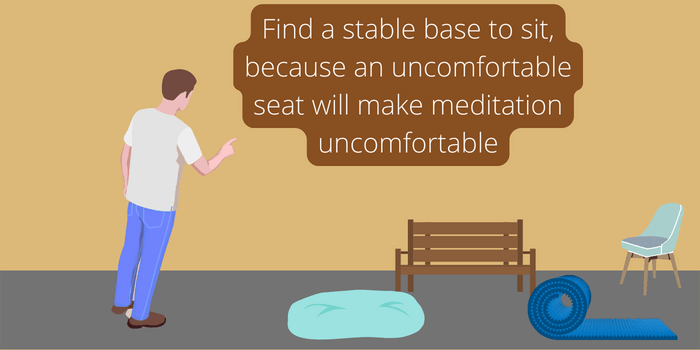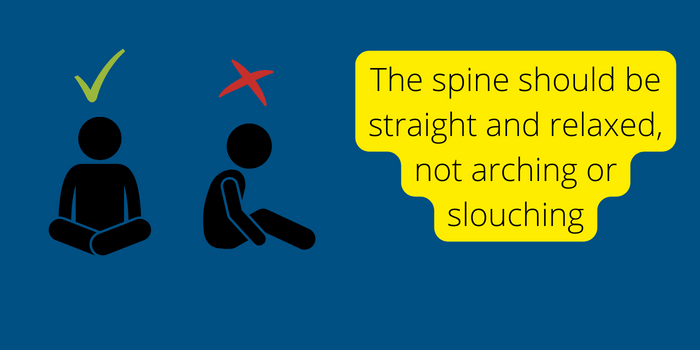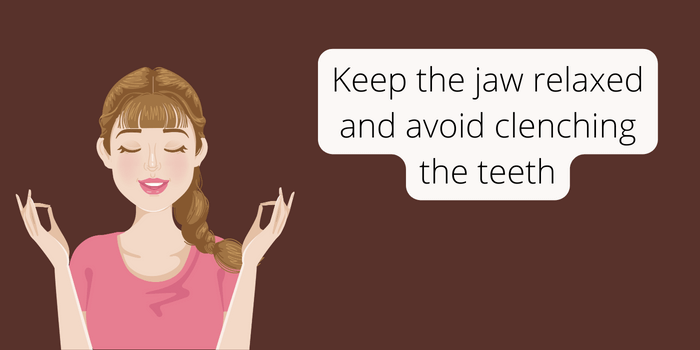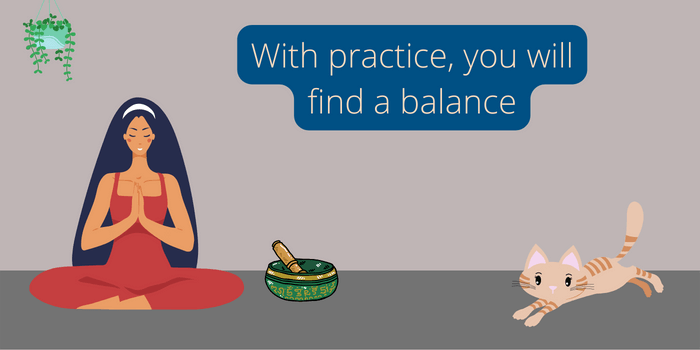There is a Buddha statue on my desk where he sits in full lotus position and calmly meditates.
In meditation, there is a lot of emphasis on the correct physical posture because the mind and body are interdependent and affect each other.
But is it necessary to sit in full lotus meditation posture to benefit from the practice?
Thankfully, the answer is no.
The Buddha or a flexible yoga instructor may find it easy to get into and comfortably sustain the full lotus where one sits cross legged and each foot is placed on the opposite thigh, but most people do not have the suppleness or the strength to access or maintain this position.
The good thing though is that you don’t have to be pedantic about the posture when you sit for meditation. As with most things in life, the best posture is the one that you can easily settle into and maintain for a reasonable duration of time.
If you cannot do a full lotus, then sit with your legs crossed in half lotus position. If sitting cross legged is too hard, use a tall meditation cushion or a chair.
While it is technically possible to meditate in any posture – sitting, standing, walking, or lying down – being seated is the best position especially for beginner meditators. No one posture is more correct than the other. A good posture is one that is comfortable, but not so comfy that you start nodding off.
The most common practice is to meditate while seated, so that is what we will cover in this article.
The right way to sit
Sit in a nice, straight comfortable position so you are not slumping forward or backward. Keep your back straight. Aim for relaxed yet strong posture, comfortable but also alert.
Our body posture affects our thoughts, so sitting in the right way can help keep our mind and heart open during meditation practice.
Imagine your head being held up by a string attached to the crown of your head, dropping down through the body. If you slump, imagine the string growing taut, lifting you up again. This mental image is helpful if you are prone to falling asleep while meditating.
A good posture involves paying attention to six points of the body:
- Seat
- Hands
- Torso
- Eyes
- Face
- Legs
Let’s look at each one of them.
The seat or base
Find a stable base to sit on. Some people sit on the floor, some on a meditation cushion, a meditation bench, or even a regular chair.
Just pick an option that suits you best. Look for a sense of being stable and balanced. You should not have to worry about losing your balance and falling over.
Find a seat with good back support, especially if you have a weak back. As you progress in meditation, you will be sitting still for progressively longer periods of time, so you need something that supports your body.
If the seat is not comfortable, the body will strain to keep the balance making meditation an unpleasant experience.
Over time, the practice itself will strengthen your muscles so you can sustain the posture for an extended period of time and still feel comfortable.
If you’re sitting on a chair or cushion, position the butt in the centre. As you first sit down, slightly wiggle back and forth to find solid ground and stability. From there, you will find it easier to settle into the right posture.
Hands
You may place your hands in a few different positions, but we will cover a couple of common options.
Simply rest the hands on your thighs, palms down. If the hands are too far back or forward on the thighs, it may pull the body out of alignment. So find a spot that feels comfortable, where your body feels stable and well in alignment. You should be sitting straight, not leaning forward or slumping back.
Another great position is to hold the hands loosely a couple of inches below the navel, palms up, right hand on top of the left. Cup the hands slightly so the thumbs almost touch.
This hand position is great for keeping you alert when you don’t let the hands rest on the lap, and instead hold them up just a little bit. This requires you to have a little more awareness to keep the hands up and prevents sleepiness.
Torso
Imagine a string running from the top of your head through the body in a straight line, and that string is lifting you up. If that straight line feels like it’s tilting forward or backward, then remind yourself to lift up again.
The spine should be straight and relaxed, not arching or slouching. Align your spine by straightening up, feeling each vertebra stack up. Sit with your back straight.
When the spine arches too much, you’re too stiff. When the spine slouches too much, then you’re too relaxed and will soon feel sleepy.
Also be aware that your shoulders are not tensed and lifted up. Relax the shoulders by purposely lifting them up once and dropping them.
Eyes
Beginner meditators usually prefer to keep their eyes fully closed, because it is easier to concentrate that way. There is nothing wrong with this, however, it is often recommended that you keep your eyes slightly open, with a soft gaze directed downwards.
Fully closed eyes may invite sluggishness and sleep which hinder meditation.
With eyes open, we are completely open to life and the present moment, with all its qualities. You are alert to whatever is going on, rather than the withdrawal you feel with eyes closed.
Training with a soft open gaze is significant because that’s how we learn to feel settled and grounded in our life, no matter what happens.
Eyes open is a gesture of that openness and intention to stay with the present, accommodating everything that is going on, rather than forcing a situation that is completely free of all obstacles.
As a beginner, you may start with your eyes fully closed, but slowly incorporate a few practice sessions with your eyes open as well.
Face
Relax the jaw with the teeth slightly apart. Relax the mouth, with the lips being closed or slightly open as you prefer.
The tip of the tongue should be soft and gently touch the roof of the mouth, just behind the upper teeth. This position keeps the tongue comfortable and reduces the flow of saliva, so you won’t get distracted by frequent swallowing.
What is important is that the jaw is relaxed and the teeth are not clenched. If you sense your jaw tensing and clenched, part your lips ever so slightly. Don’t open your mouth wide like a fish, just slightly part the lips so the gap is barely visible.
If any part of the face feels like it is holding some tension, notice that and intentionally release the tension.
Legs
Cross the legs comfortably in front of you if you are sitting on a cushion or on the floor.
If the knees are above the thighs, then your back, hips, and neck will begin to strain. Place a cushion or folded blanket under your knees for support. If you have long legs, you may need a taller cushion.
If you are sitting on a chair, place your feet flat on the floor. For those with knee pain, sitting on a chair would be preferable.
If the chair is too high and the feet dangle above the floor, place a footrest on the floor so the feet can be placed on that.
Sit straight and alert, without leaning too much on the back of the chair unless you really have to.
Dealing with discomfort
The correct posture is one that keeps your mind and body comfortable and happy, free from strain and tension.
Sitting still for a long time is challenging, especially for beginners. Expect some discomfort and aches. As long as you are not aggravating any pre-existing injury, some discomfort that arises from the practice should be tolerated.
Observe how the mind and body reacts to sitting still.
As you progress in the practice, it will get easier to sit still. Stay with the practice and stay patient. Eventually, you will be able to sit for an hour or more without feeling uncomfortable or stiff.
Don’t keep fidgeting to adjust your posture. Remain still as long as you can, even when you feel mild discomfort. This can be challenging for a beginner.
Then move slowly and deliberately to adjust the posture, without stopping the meditation. Be fully aware of all sensations.
Soon you may notice that a new discomfort has replaced the old one. When you feel mild discomfort, don’t worry that you’re doing something wrong or somehow not sitting the right way. Some physical discomfort is normal and expected.
It is not possible to overcome all irritation and discomfort by continually adjusting the posture. Learn to find a balance.
Pointers to keep in mind
Here is a quick summary to help you settle into a good posture in your next meditation session.
Sit straight, with the spine like a stack of coins
Buddhist texts instruct you to imagine the spine being like a stack of coins. Of course, we know that the spine has a natural curvature, but this image is helpful to get a sense of stability and balance. A stack of coins would tumble over if it leans too forward or back.
Hold the head up, like a puppet on a string
Imagine a string attached to the crown of your head, and it is lifting you up. Elongate the spine. As you breathe in, draw yourself upward as though being pulled by the string. As you breathe out, relax the face, neck, shoulders, and arms. This helps gain the right alignment and relaxation that make a great posture.
Sit like a mountain
Meditation masters advise to sit like a mountain – stable, unmovable, majestic. Once you have found the required alignment and relaxation, imagine yourself to be an unmovable mountain, deeply rooted into the ground, stable. Remain still, with the magnificence of a mountain.
Find your balance
With a good meditation posture, you will feel a sense of being balanced perfectly. You’re not leaning forward or backward, left or right. To find this centre where you feel at ease, rock your body gently back and forth or side to side, as you take your seat. Your body will naturally come to rest in the centre.
Let the body reflect the mind
The quality that we aim to cultivate in the mind is one of being relaxed, yet alert. Let your physical posture reflect that. The mind strays off balance if you are too excited or too sluggish. A good posture can help combat this by maintaining the perfect balance between being alert and upright, but also comfortable and relaxed at the same time.
Symmetry of the body
For a great meditation posture, the right side of your body should be a mirror image of your left.
Don’t sit lopsided or leaning to one side. Adjust the posture so that both knees and shoulders are level. It can help if you ask someone to take a picture of you meditating, to see if you need to make further tweaks in your posture.
Next: Mental attitude
As important as the right physical posture is the right mental attitude to bring to meditation. I will cover that in the next article in this series.

Become A Morning Person Bootcamp
For calm mornings with a daily meditation & journaling routine

